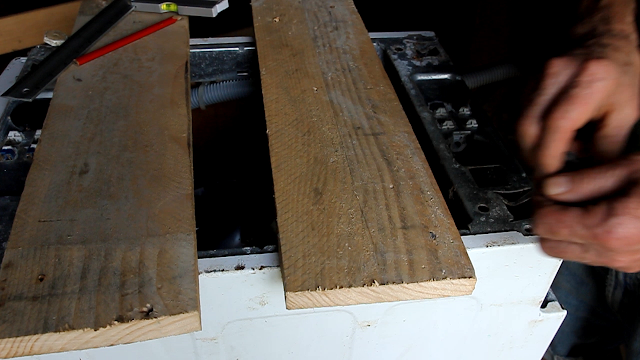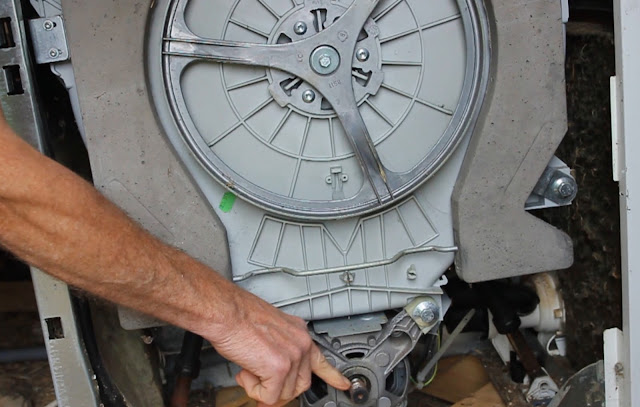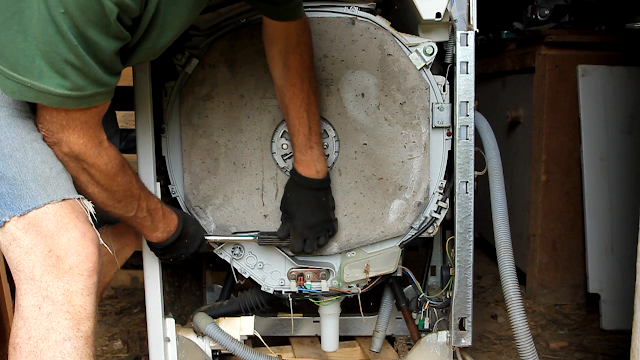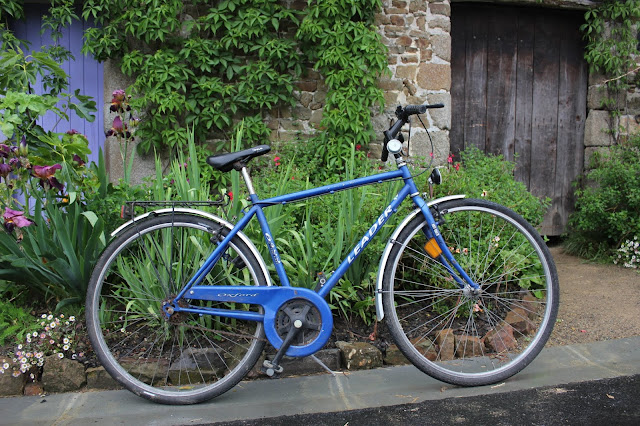I have already mentioned that it was my intention to support the bicycle on wooden supports but I had to reuse the original metal supports due to the forthcoming exhibition. Now that was behind us, I could make the front and rear bicycle supports from recuperated pallet wood.
The important dimension was the height of the stand necessary to obtain the clearance between the pedal at its lowest point and the pallet. In my case this was about 12" (300mm). The vertical supports of the stands were stiffened with angled braces which extended to the stand base. Each stand had front and rear 'feet' which were screwed to the pallet and extended across at least 4 of the pallet's planks (this was to distribute the weight of the bicycle and the cyclist).
To give you some sort of idea of the sizes of material used, I list them below:
Stand uprights: 3" x 1" x 12½" (75mm x 25mm x 310mm)
Base: 3" x 1¾" x 8½" (75mm x 32mm x 210mm)
Feet: 13" x 3½" x ⅝" (325mm x 85mm x 15mm)
These are all recuperated untreated pallet wood.
The bicycle fork ends were supported on 10mm threaded bar.
For fitting the the supports onto the length of the pallet, I made both of them in the shape of a right-angled triangle.
The rear support comprised the uprights, glued and screwed to the base. The diagonal braces were glued and screwed to the inside faces of the uprights but did not go to the top of the upright so as to permit the fitting of the fork ends onto the supporting bar.
Packing pieces of the same thickness as the uprights were glued to the inside face of the base so that the braces could be screwed to a flat face at the same level as that of the uprights. Once the glue was dry, the stand was glued and screwed to the two 'feet' and the clearance holes for the supporting threaded bar were drilled in the uprights about 1" from the top edge.
 The front support was a slightly different design in that I needed the fork end nearest the washer to be on the outside face of the support. This was so that the bicycle chain wheel would align with that on the machine. To avoid having to do this asymmetrical arrangement I could have made the chain wheel on the drum shaft stick out further by increasing the thickness of the piece of wood on the shaft. I also made a housed joint for the one upright (see image).
The front support was a slightly different design in that I needed the fork end nearest the washer to be on the outside face of the support. This was so that the bicycle chain wheel would align with that on the machine. To avoid having to do this asymmetrical arrangement I could have made the chain wheel on the drum shaft stick out further by increasing the thickness of the piece of wood on the shaft. I also made a housed joint for the one upright (see image).
The support was also asymmetrically mounted on the feet to ensure the proximity of the bicycle to the machine. As with the rear support the holes for the threaded bar were drilled 1" from the top edge of the uprights.
The first step was to ensure that the washing machine was pushed as far as possible on its two fixing bolts in the slotted holes away from the end edge of the pallet so that once the chain was attached, the machine could be moved further from the bicycle's chain wheel so as to increase the chain tension and also to compensate for any minor misalignment.
The two supports were placed in their approximate positions on the pallet and the threaded bars were put in place. The bicycle was lowered onto the bars and fixed in place with nuts. Note that washers and nuts were also on the inside faces of the stands so that they would allow the clamping nuts to be tightened. If these nuts were not there then tightening the outside nuts would merely squash the forks and the top of the supports together.
Now fixed to the supports, the chain could be fitted between the bicycle and the washing machine and the alignment of the two chain wheels could be checked.
Once it was O.K. the supports were screwed to the pallet. Because the support feet were at the ends of the pallet, the screws fixing the feet went through the top planks and into the pallet's stringer board. On the 'inboard' feet I screwed through the top planks and into a plank similar in size to the support feet.
The machine was ready to go!
The whole project has been made into an omnibus video version with the stands as the last part:
If you read this article and found it interesting then share it with your friends on social media or suchlike. Please also feel free to ask questions and or make comments and if you found this helpful and would like to support this site you can always 
© Andy Colley 2019
The
most frequent reasons for machine failure is of an electrical or
electronic nature. Neither of these preclude using it, as long as the
drum is watertight. Even if you don't already own a broken machine I can
guarantee that..read more
We’ve exhibited this machine on many occasions and the most frequent
comment from spectators has been ‘let’s see you spin dry now!’...read more
The important dimension was the height of the stand necessary to obtain the clearance between the pedal at its lowest point and the pallet. In my case this was about 12" (300mm). The vertical supports of the stands were stiffened with angled braces which extended to the stand base. Each stand had front and rear 'feet' which were screwed to the pallet and extended across at least 4 of the pallet's planks (this was to distribute the weight of the bicycle and the cyclist).
To give you some sort of idea of the sizes of material used, I list them below:
Stand uprights: 3" x 1" x 12½" (75mm x 25mm x 310mm)
Base: 3" x 1¾" x 8½" (75mm x 32mm x 210mm)
Feet: 13" x 3½" x ⅝" (325mm x 85mm x 15mm)
These are all recuperated untreated pallet wood.
The bicycle fork ends were supported on 10mm threaded bar.
For fitting the the supports onto the length of the pallet, I made both of them in the shape of a right-angled triangle.
The rear support comprised the uprights, glued and screwed to the base. The diagonal braces were glued and screwed to the inside faces of the uprights but did not go to the top of the upright so as to permit the fitting of the fork ends onto the supporting bar.
Packing pieces of the same thickness as the uprights were glued to the inside face of the base so that the braces could be screwed to a flat face at the same level as that of the uprights. Once the glue was dry, the stand was glued and screwed to the two 'feet' and the clearance holes for the supporting threaded bar were drilled in the uprights about 1" from the top edge.
 The front support was a slightly different design in that I needed the fork end nearest the washer to be on the outside face of the support. This was so that the bicycle chain wheel would align with that on the machine. To avoid having to do this asymmetrical arrangement I could have made the chain wheel on the drum shaft stick out further by increasing the thickness of the piece of wood on the shaft. I also made a housed joint for the one upright (see image).
The front support was a slightly different design in that I needed the fork end nearest the washer to be on the outside face of the support. This was so that the bicycle chain wheel would align with that on the machine. To avoid having to do this asymmetrical arrangement I could have made the chain wheel on the drum shaft stick out further by increasing the thickness of the piece of wood on the shaft. I also made a housed joint for the one upright (see image).The support was also asymmetrically mounted on the feet to ensure the proximity of the bicycle to the machine. As with the rear support the holes for the threaded bar were drilled 1" from the top edge of the uprights.
 Fitting the bicycle on the pallet
Fitting the bicycle on the pallet
The first step was to ensure that the washing machine was pushed as far as possible on its two fixing bolts in the slotted holes away from the end edge of the pallet so that once the chain was attached, the machine could be moved further from the bicycle's chain wheel so as to increase the chain tension and also to compensate for any minor misalignment.The two supports were placed in their approximate positions on the pallet and the threaded bars were put in place. The bicycle was lowered onto the bars and fixed in place with nuts. Note that washers and nuts were also on the inside faces of the stands so that they would allow the clamping nuts to be tightened. If these nuts were not there then tightening the outside nuts would merely squash the forks and the top of the supports together.
Now fixed to the supports, the chain could be fitted between the bicycle and the washing machine and the alignment of the two chain wheels could be checked.
Once it was O.K. the supports were screwed to the pallet. Because the support feet were at the ends of the pallet, the screws fixing the feet went through the top planks and into the pallet's stringer board. On the 'inboard' feet I screwed through the top planks and into a plank similar in size to the support feet.
The machine was ready to go!
The whole project has been made into an omnibus video version with the stands as the last part:
Until next time and from a sunny day in Normandie,
Cheers, Andy
© Andy Colley 2019
RELATED ARTICLES
 Convert Your Washing Machine to Pedal Power Part 1 - Getting Started (Top-Loader)
Convert Your Washing Machine to Pedal Power Part 1 - Getting Started (Top-Loader)
The
most frequent reasons for machine failure is of an electrical or
electronic nature. Neither of these preclude using it, as long as the
drum is watertight. Even if you don't already own a broken machine I can
guarantee that..read more
 How to Convert your Washing Machine to Pedal Power 1 - The Basic Model (Front-Loader)
How to Convert your Washing Machine to Pedal Power 1 - The Basic Model (Front-Loader)
The electronic fault that arose in our automatic washing machine
rendered it useless. I knew that the machine was watertight and...read more
 How to Convert your Washing Machine to Pedal Power 2 - Modifications (Front-Loader)
How to Convert your Washing Machine to Pedal Power 2 - Modifications (Front-Loader)
We’ve exhibited this machine on many occasions and the most frequent
comment from spectators has been ‘let’s see you spin dry now!’...read moreMake a Pallet Wood Creel or Overhead Drying Rack
Cheap and cheerful engineering in the practical use of recycled,
untreated pallet and fruit crate wood - for drying clothes, herbs,
flowers...read more













































